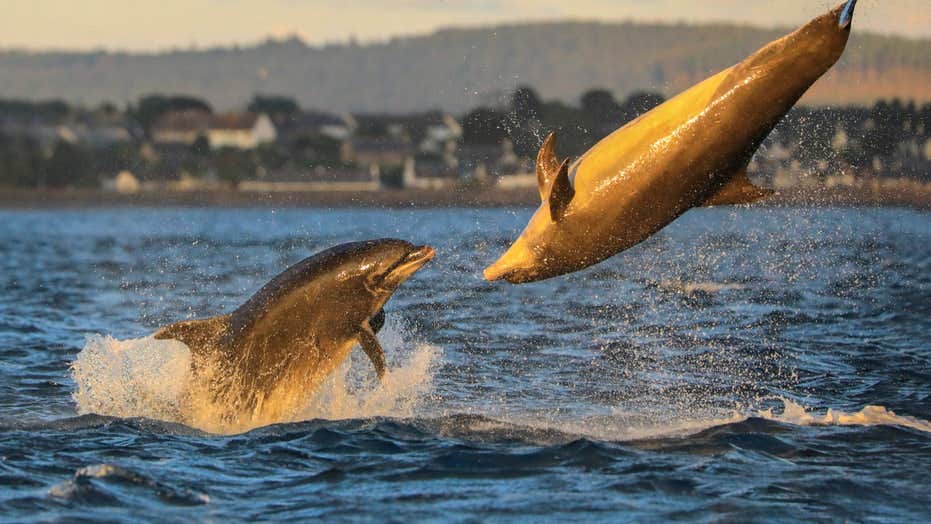Researchers uncover new insights into dolphins, genetics and habitat
Ocean-dwelling dolphins have repeatedly adapted to life in coastal areas throughout history. It is important to learn more about them.

[Dec 9, 2021: Staff Writer, Norwegian University of Science and Technology]
Dolphins flipping and playing off the shore of Southern California. (CREDIT: Creative Commons)
Ocean-dwelling dolphins have repeatedly adapted to life in coastal areas throughout history.
In a world that is constantly changing – perhaps faster than over multiple generations – it is important to learn more about how different species adapt to new conditions.
How can dolphins adapt to life in a new environment on repeated occasions and seemingly independently, for example? A research group has now found an answer to this question. The newly published results are presented in Science Advances. Andrew Foote is an associate professor at the the Norwegian University of Science and Technology's (NTNU) Science Museum and participated in the study.
Common species
Bottlenose dolphins are perhaps the most well-known marine dolphins and normally live in groups called schools or pods. These are the dolphins you usually find in large aquariums, because they are relatively easy to train. People over 50 will nod in recognition of Flipper, the star of a popular American TV show in the 1960s.
In the wild, dolphins are spread across a wide belt both north and south of the equator. You will often find them in pods far out to sea, where they mainly feed on fish, and otherwise on whatever they can find in the way of squid and crustaceans.
Related Stories
Bottlenose dolphins belong to at least two different species. But you can also find variations within the same species. Perhaps the most striking feature is that they are able to thrive in completely different environments.
Genes and behavior inform lifestyle
Bottlenose dolphins are not only found in the open ocean. On repeated occasions, in several places and seemingly independently, dolphins have also adapted to life along the coast.
The coastal lifestyle can differ considerably from life at sea, especially because the diet may be completely different. These variations are reflected in the dolphin’s genetic make-up.
Genes that provide an advantage will more often than not be passed on to the next generation. Over several generations, this can lead to substantial differences between groups of animals living in varied habitats.
“The dolphins that live along the coast and out at sea are genetically different from each other,” says Marie Louis at the University of St. Andrews in Scotland.
Some genes provide benefits for living in the open ocean, while other genes are advantageous for coastal living. Dolphins along the coast may have larger teeth, for example, a characteristic that is probably related to their diet. They also have other physical traits that can be beneficial for living closer to land.
Some traits may also be learned rather than genetic. Dolphins along the coast are more place-bound than those far out to sea, but they may have learned this behaviour from their mothers. The same goes for different techniques for obtaining food.
Answer lies in ancestral genes
How bottlenose dolphins adapt to different habitats in several places on the planet has posed a little mystery. Apparently they have adapted totally independently of other dolphins which have done the same thing in completely different places. That mystery is now solved.
Sampling location and population structure of coastal and pelagic common bottlenose dolphins. (CREDIT: Science Advances)
“We discovered the solution in the ancestral genes that dolphins have. We found that genes that provide benefits for coastal dolphins also appear as genetic variations in dolphins that live far out to sea,” says Louis.These ancient genes are not only found in dolphins along the coast, although they are far more common there. When necessary, open ocean dolphins have the genetic potential to adapt to coastal life.
“This adaptation has happened several times in dolphin pods, independently of each other but in parallel,” Foote said.
Ancestral genes have been triggered several times
In bottlenose dolphins, therefore, the ancestral genes have been triggered on repeated occasions and in repeated places throughout history, the research group's study shows.
“In other words, a species that lives in groups can benefit from both the ecological possibilities in the environment and the genetic variation to adapt to a new habitat over and over again,” says Louis.
Several species may depend on latent ancestral genes to adapt to later changes, even though they apparently are not needed today.
In an ocean-dwelling dolphin pod that for one reason or another began to live closer to shore, the individuals who carried these ancient genes had an advantage over the individuals who did not have them. They thus multiplied more often and had viable offspring who in turn would have the same genetic advantage.
"Through the generations, these beneficial gene variants came to dominate in the coastal dolphins, so much so that they became clearly genetically different from the ones in the open ocean," says Louis.
A number of species may depend on latent ancestral genes to adapt to later changes, even though they apparently are not needed today. Wide genetic variation can thus determine how well individuals, and in turn species, are able to cope when conditions change.
For more science and technology news stories check out our New Discoveries section at The Brighter Side of News.
Note: Materials provided above by Norwegian University of Science and Technology. Content may be edited for style and length.
Like these kind of feel good stories? Get the Brighter Side of News' newsletter.
Tags: #New_Discoveries, #Dolphins, #Migration, #Oceans, #Genetics, #Research, #Science, #The_Brighter_Side_of_News
Joseph Shavit
Head Science News Writer | Communicating Innovation & Discovery
Based in Los Angeles, Joseph Shavit is an accomplished science journalist, head science news writer and co-founder at The Brighter Side of News, where he translates cutting-edge discoveries into compelling stories for a broad audience. With a strong background spanning science, business, product management, media leadership, and entrepreneurship, Joseph brings a unique perspective to science communication. His expertise allows him to uncover the intersection of technological advancements and market potential, shedding light on how groundbreaking research evolves into transformative products and industries.



